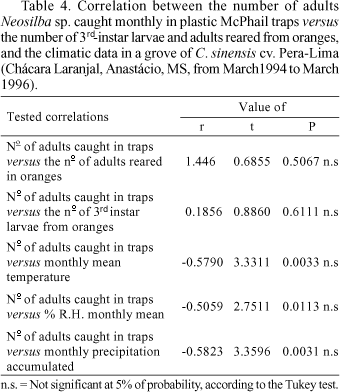This paper evaluated the capture of frugivorous flies (Tephritidae and Lonchaeidae) with plastic McPhail traps, in two commercial citrus groves, located in the municipalities of Anastácio and Terenos, in the state of Mato Grosso do Sul, Brazil. The aim of this work was to determine the populational fluctuation of adult frugivorous flies, and to study its relationship with the damaged fruits in the groves. The traps were placed about 30 m apart over the entire area in both groves, hung up approximately 1.70 m high from soil, in the canopy of the citrus plants. Eight traps were installed (two traps/ha) at Anastácio and 21 traps in Terenos (one trap/ha). The traps were baited with the hydrolyzed corn protein (5%) TephritidTM (food bait). Evaluations were carried out from March 22, 1994 to March 23, 1996. Ceratitis capitata (Wiedemann) and 25 species of Anastrepha were caught during several months in both orange groves, but no fruit fly species were found infesting oranges. Neosilba sp. was caught from the traps during all the experiment and was also reared from the damaged oranges, thus suggesting that that fly can be a pest. The predominant species of frugivorous flies caught in the traps were: Neosilba sp., C. capitata, Anastrepha punctata Hendel and A. sororcula Zucchi. There was no correlation between adult frugivorous flies caught in the traps and the number of larvae and adult flies reared from the infested oranges collected in the groves.
Fruit fly; McPhail trap; Anastrepha; Ceratitis capitata; Neosilba








